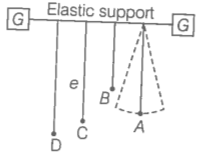Four pendulums \(A,B,C,\) and \(D\) are suspended from the same elastic support as shown in the figure. \(A\) and \(C\) are of the same length, while \(B\) is smaller than \(A\) and \(D\) is large than \(A.\) If \(A\) is given a transverse displacement,

| 1. | \(D\) will vibrate with maximum amplitude. |
| 2. | \(C\) will vibrate with maximum amplitude. |
| 3. | \(B\) will vibrate with maximum amplitude. |
| 4. | All four will oscillate with equal amplitude. |


© 2026 GoodEd Technologies Pvt. Ltd.